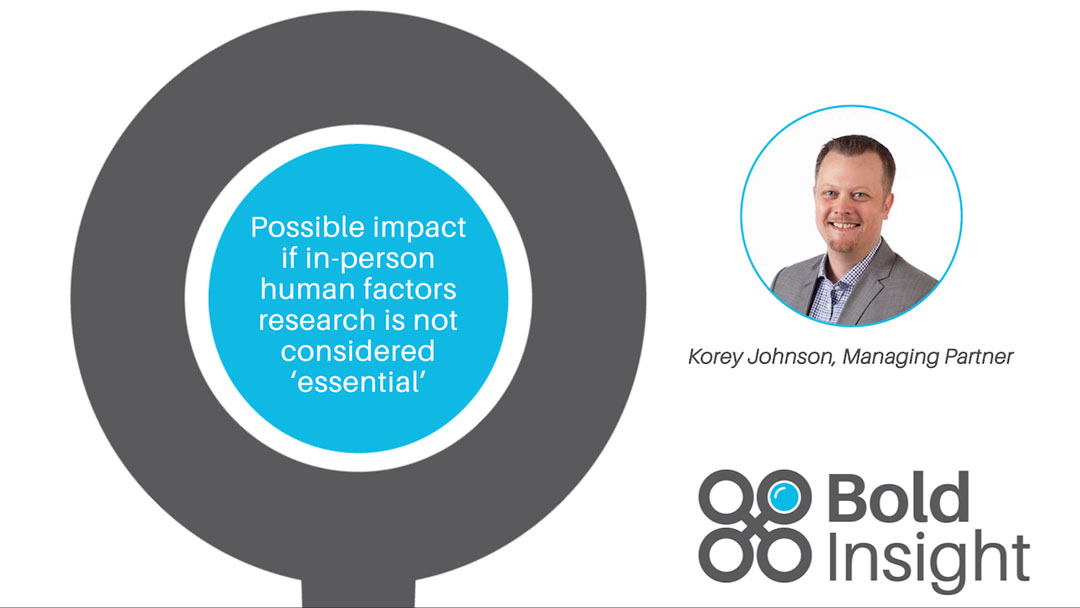“How can we help?”
This is a question we have found ourselves asking both personally and professionally amidst unprecedented events caused by COVID-19. As a company, over half of our work is involved in healthcare, so we feel invested to help solve these problems. From working alongside our clients on innovative medical devices to interviewing healthcare providers (HCPs) and patients to understand the struggles they face so we can help design better solutions, we are passionate about supporting those who are on the front lines battling this virus.
Our initial discussions on COVID-19 were inspired by a webinar put on by the Human Factors and Ergonomics Society (HFES), where ShanQing (SQ) Yin (PhD), Assistant Director of Human Factors & Systems Design at KK Women’s & Children’s Hospital in Singapore, talked about his experiences with the COVID-19 crisis. Specifically, he shared challenges faced by medical professionals in the in-patient, acute care hospital setting.
We have compiled some ideas shared from Dr. Yin’s presentation, and also included some insights of our own from working within the medical space as UX researchers and designers. We have aggregated some considerations for HCPs, healthcare organizations, and others involved in the medical space.
1. How can medical professionals be differentiated when everyone is wearing the same protective equipment and voices are being muffled behind masks?
To address this challenge of differentiating suited-up HCPs, one suggestion is to use labels and stickers to clarify from which department the medical professional represents. Color-coding, such as through PPE colors or scrub colors, could be another option to help differentiate individuals.
Common categories of HCPs on the front lines of COVID-19 in hospitals include:
a. Nurses;
b. Primary Care Providers (PCPs), which includes Physicians, Nurse Practitioners, and Physician’s Assistants;
c. Pharmacists;
d. Technicians, which includes Medical Assistants and Certified Nursing Assistants;
e. Transporters;
f. and Respiratory Therapists.
2. How can information be relayed without contamination between staff working bedside to those outside of the isolation unit?
Coordinating information between patient rooms or wards can be difficult when trying to keep contamination within one area. A helpful tool for information coordination is the use of simple signs and warnings. For example, using strategically placed signage on brightly colored paper could trigger a reminder for an HCP to remove contaminated PPE before transitioning to a different ward.
3. Personal Protective Equipment (PPE) such as gowns, face masks, and face shields are in limited supply; what can be done to either increase the supply or make existing supplies last longer?
One of our colleagues, Shelly Holbrook, has been very involved in understanding this particular challenge, and commented on what she has learned over the past week:
“Unfortunately, there is no simple or quick fix for the bottlenecks many hospital supply-chains are currently facing. In the interim, some hospitals have been reviewing their needs and doing what makes the most sense for their given circumstances. These measures have included relaxing hospital guidelines to allow for non-FDA approved PPE in emergency situations (e.g., 3D printed face shields, DIY hand sewn masks, KN-95 masks), while other hospitals have instituted careful measures to conserve and re-use FDA-approved PPE for longer.”
For those interested in creating PPE, whether it be of the DIY variety or through larger-scale, FDA-certified efforts, we recommend you consider the following questions in your design process:
a. Fit – Does it fit a variety of face sizes? Is it secure? Can it be adjustable?
b. Durability – How many times can it be used? Does the quality degrade over time and does this effect use?
c. Instructions – Does the sanitation process require certain steps to follow? How about the donning / doffing process?
d. Testing the PPE – is there a correct range of motion for needed activities? Does it stay on over time? Is it comfortable?
4. How should staff be prepared to properly sanitize and reuse materials as well as operate machinery with which they may not have immense experience?
Instructions for use (IFU) are a critical component of the overall design of medical devices, and this becomes even more apparent when there is a desperate need for HCPs to quickly adapt and learn new techniques and/or technologies when they are triaged to different hospital departments. With IFU development and design as one of our key offerings for our medical clients, we often help design “Quick Tips” instructions to help new or infrequent users quickly learn how to properly use a medical device without relying on the entire IFU. Although the use of Quick Tips as an instructional aid comes with its own inherent risks, the implementation of Quick Tips for medical devices (e.g., respirators, ventilators) could help reduce some of the training burden on both the healthcare organization and the individuals who are new to using the devices.
In addition to IFU design, other simple, informational posters and handouts could easily depict and refresh memories on how to put on and take off PPE to reduce the spread of COVID-19.
5. When everything is moving at a very fast pace, especially in surgery, it can be hard to differentiate protective gear sizes. Sometimes the wrong size is used which can lead to supply waste or insufficient protection; what can be done to help?
Design labeling and/or icons to indicate bag sizes for goggles can help lead to less waste. Organization of supplies in areas ranging from smaller to increasing sizes, separate from each other could also help with easier visibility on supplies levels.
6. What is the best way to share information to all medical personnel regarding the rapid updates on WHO and CDC guidance?
We encourage the creation of a single location to organize information from the CDC and WHO in a template that can be easily updated, shared, printed, and laminated as new information comes out. These updates should be shared in multiple communication channels (e.g., email, flyers, etc.) to ensure that people receive the most up-to-date information whether they are currently scrubbed up or off the clock, but preparing to head into the hospital.
7. What can be done to help prepare patients who test positive for COVID-19 and they need to go into isolation? How can we help patients be more prepared for the road ahead?
Many patients and their family members will likely not be prepared to go into isolation if the need arises. Dr. Yin discussed the benefits of using telehealth services with caregivers and families to help assess and ease fears and anxieties. To facilitate communication between patients in isolation with their family members, we suggest having a supply of phone chargers, headphones, etc. to help with the transition in communication styles while they are unable to directly interact. Maintaining communication for patients in isolation is increasingly important as isolation can lead to feelings of loneliness and anxiety, which can exacerbate medical conditions and overall health.
It is also recommended that as hospitals, field hospitals, and other healthcare organizations see increasing numbers of COVID-19 patients enter their organizations, that patients have an information sheet describing what to expect with answering some common questions, such as:
a. How long will isolation last?
b. What should I pack?
c. Who is allowed to visit and when?
d. How can I communicate with my family while I am in isolation?
Please note that this is not an exhaustive list, so we encourage our industry colleagues to keep brainstorming ways to support HCPs and patients as we navigate this uncertain time. Our team continues to search for more ways to contribute to and give-back as much as we can both professionally and personally.
On a personal note, we are also extremely proud of some of our team members, who, in their free time, have been reaching out to their personal networks to support local hospitals with the growing PPE shortage. Recently interviewed by Wired magazine and featured on the local news about their efforts, they are showing what a difference a few, motivated individuals can make!
Related content:
Webisode: Possible impact if in-person human factors research is not considered essential
Korey Johnson describes considerations for the FDA if in-person research continues to be impacted longer than anticipated, alternatives to in-person research, and reasons this research is considered essential.

